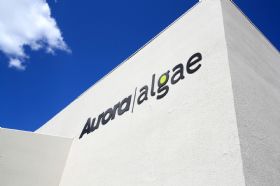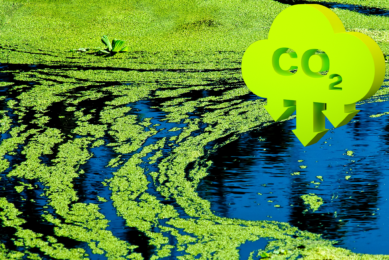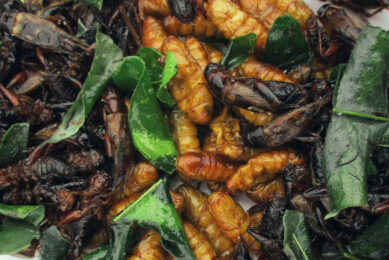With a continuous growth of the world’s population, humanity faces some major food and fuel-related challenges ahead. Our agriculture and aquaculture resources are already stressed, and our rising demand for energy is mostly dependent upon an antiquated and unstable fossil fuels-based system. Meanwhile, many of the supposed solutions the world is focused on use terrestrial crops to address our energy crisis, creating a new issue of fuel vs. food and feed. The challenge is finding sustainable alternatives that ideally address both food/feed and fuel needs while leveraging the finite resources this planet has to offer. The solution may very well be found in one of the world’s oldest forms of plant life: Algae. Aurora Algae, based in the US with productions sites in Australia, threw down the gauntlet and made a serious business with real products stemming from algae. We talked to vice president of business development, Leslie van der Meulen.
"There are thousands upon thousands of algae strains in the world and a variety of ways to grow, harvest and extract the biomass into usable goods. Aurora Algae has taken a high-tech farming approach to the algae growing process, using a proprietary natural strain of marine (salt water) algae. When grown in open raceway ponds with our proprietary cultivation and processing systems, the end result is a single platform of sustainable, vegetarian algae products at attractive price points.
Aurora’s scientists have spent several years getting to know its particular algae strains while isolating and optimising beneficial characteristics. Its proprietary algae is a lighter green colour which uses light more efficiently and reproduces at double the rate of most wild strains. Our algae thrive in arid, hot environments with access to salt water, making it ideal to grow in areas normally considered unsuitable for agricultural production. Rather than destroying forests to plant crops, our algae ponds create productive agricultural land where there once was none.
Since the company grows marine algae, fresh water use is minimised. In fact, Aurora’s algae growing process uses approximately one percent of the fresh water needed to grow soy on a per tonne basis and a fraction of the water used to raise chicken, pork or beef. Moreover the protein produced yields almost 40 times the protein per acre of crop.
Rather than using sugars, yeast or other land-based commodities as feed for the algae, we have opted for CO2 emissions from industrial plants as a feedstock. Since our photosynthetic process actually helps to reduce carbon emissions, the resulting platform of our products are carbon neutral-to-negative while meeting growing market demands and positively addressing global hunger, health and resource scarcity issues.
Economic viability
We have the unique ability to simultaneously produce a various number of products, which makes the algae solution more economically viable. Let me elucidate a bit more on the products. To start with we market all products under the A2 brand. A2Feed is a high-performance fish feed for the aquaculture and other animal feed markets and is set to become a much needed alternative. It is a natural, sustainable food source for farm-raised fish, and will offer the aquaculture industry a feed native to a fish’s diet, rather than supplementing its diet with soy and corn. With A2 Omega-3 and A2 EPA Pure we try to address mounting obesity and cardiovascular health problems, offering a fish-free Omega-3 EPA oil to serve as an alternate source to the growing demand for EPA and DHA Omega-3 oils. This new scalable, renewable source supports the increasing demand for these oils and allows for the development of new pharmaceutical applications not previously possible with fish-based Omega-3s.
A2 Fuel is a high-performance biodiesel for use in a variety of industries, including transportation, and will help reduce dependence on overseas oil resources while providing a sustainable source of biofuel for various industries. Finally A2 Protein will help address global protein shortages and increasing demand for rich proteins, while reducing the need to increase production of whey, soy, nuts, livestock and fish-based products.
Solving the scalability problem
A critical component of this new solution is scalability. Since the business is based on growing, it would not be viable to have a harvesting season limited by weather. In order to keep the financial model whole, we needed to identify a location which allows room for expansion and reasonably-priced land.
After a global search for the optimal conditions and resources to grow our unique algae strains, we finally settled on Western Australia as the first location for a commercial scale facility. The area boasts some of the best solar radiation on the planet, with minimal rainfall and consistent warm temperatures. There are thousands upon thousands of acres of arid land, ideally situated along the ocean and co-located with mining and refineries that are happy to divert their CO2 emissions for a good cause. In May of 2011, we officially opened a demonstration facility in Karratha, Western Australia. The site boasts 38 micro-ponds, four 50 m2 ponds, four 400 m2 ponds, six 4,000 m2 ponds and a backend processing centre that is harvesting 15 tonnes of biomass per month. The company has also secured around 600 hectares for its first commercial scale facility. Design of the facility is in progress and construction is expected to begin in Q1 2012, beginning with 100 hectares of production ponds, a nearly endless supply of CO2, access to seawater and thousands upon thousands of hectares of arid land for expansion.
This facility marks a crucial step in proving the scalability of the process and the ability to produce volumes of biomass that can become a consistent supply to various feed, Omega-3, fuel, and protein markets. We expect to grow volumes of A2 Feed to well over 500,000 metric tonnes annually from the Australia locations, and we have already identified several other ideal locations around the globe for further expansion.
The proof is in the process
Our patented end-to-end process makes use of many proven technologies, conveniently adjusted to work with micro algae. Using a scaling system to inoculate the 400 m2 ponds, Aurora’s algae are grown to target densities in smaller ponds before being ported over into bigger ponds and ultimately into the 400 m2 size. Once in these ponds, a continuous harvesting takes place based on the speed with which the algae grow (or duplicate). Given the excellent growing climate and optimum solar radiation of Western Australia, our algae products will be available year-round and have no delays in terms of harvesting seasons. Freshness is therefore guaranteed.
After the algae are harvested, the extraction process provides us with the earlier mentioned products. The remaining biomass is an algal wax containing pigments, antioxidants, etc.
While there is no silver bullet to fix the world’s problems, algae is a new breed of solutions-driven cash crop: a prolific, infinitely scalable and highly efficient organism which doesn’t create new problems of its own. As the scientific community continues to unlock the potential of algae, this simple, resilient organism may prove to be the world’s first sustainable commodity."
Detailed product specifications are available through www.AuroraInc.com.
More algae initiatives Around the world many more initiatives have started to make feed and fuel ingredients from algae. The most large scale operations are intended to make biofuel. Fewer operations also aim to produce products for the food, feed and pharmaceutical industry. Below are just a random selection of some other algae initiatives. Danish processing equipment company GEA Niro is leading a new initiative that converts CO2 into fuel alcohol, proteins for animal feed and fertiliser for agricultural purposes, by feeding the CO2 to algae and transforming the algae to alcohol by fermentation and the residual bio matter to fertiliser. The exhausted yeast cells are then spray dried into protein powder for animal feed. Currently there are extended tests running in Spain for growing algae’s in connection with a cement plant. Preliminary analysis suggests that it is a successful process for reducing CO2 emissions. Founded and based in Vienna, Austria, See-O-Two (“SOT”) provides technology for industrial-scale production of micro-algae-based biomass. Within the process, CO2 from emissions is converted into biomass. SOT has been founded in 2008 and runs R&D facilities in Timelkam, Upper Austria and Wallenhorst, Germany. Additional R&D cooperation’s are located in Bremen, Germany and Marysville, Ohio, USA. SOT uses covered ponds and tanks to grow the algae. PetroAlgae Inc was founded in 2006 and is based in Melbourne, Florida, USA. The company is a licensor of a technology for improving the growth and harvest rate of naturally occurring aquatic microorganisms (micro-crops) in a consistent and commercial manner. The company makes use of large open bioreactors. It operates a commercial demonstration facility in Florida. A facility in Chile is under construction and there is a smaller operational facility in Suriname using PetroAlgae’s technology. |












